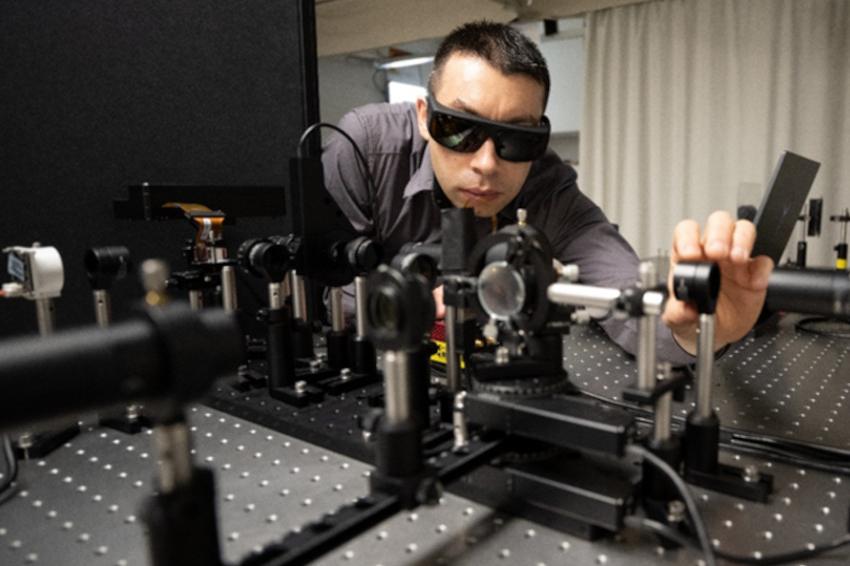New lens analysis approach could improve treatments for nearsightedness
19.05.2023 - Instrumentation recreates properties of the myopic eye to test lenses that prevent visual decline.
Researchers have developed new instruments for rigorously quantifying and comparing the light focusing properties of specialized eyeglass lenses that are used to slow the progression of myopia, or nearsightedness. The information gained with this new approach could help inform future lens designs that are even more effective at preventing visual decline.
Nearsightedness is on the rise around the globe, especially among children. If current trends continue, half of the world’s population will be nearsighted by 2050, according to a report from the Brien Holden Vision Institute in Australia. Although the drivers of this worrisome trend aren’t entirely clear, specialized eyeglass lenses have been shown to keep myopia from getting worse. This is particularly important for children and teens who often experience progression in the condition as their bodies grow. Now, researchers from the Zeiss Vision Science Lab at the University of Tübingen and the University of Murcia in Spain created a new instruments, which measure lens performance under real-world viewing conditions. They also report results from measuring the light focusing characteristics of different lenses used to slow myopia progression.
“Insights into the link between the optical properties of myopia progression management lenses and effectiveness in real-world scenarios will pave the way to more effective treatments,” said Augusto Arias-Gallego from the Zeiss Vision Science Lab. “This could help millions of children and is fundamental in understanding the mechanisms by which these lenses work. Myopia is typically caused when a person’s eyes become slightly elongated. This leads faraway objects to appear blurry because they are focused in front of, rather than onto, the retina. Although traditional eyeglass lenses can correct this blurriness, conventional lenses don’t prevent myopia from getting worse. Myopia progression can increase the likelihood of other eye problems and irreversible blindness.
Lenses that modify retinal signals to reduce myopia progression have been clinically tested and are currently available in the market. Researchers hypothesize that these lenses slow the growth of the eyeball, preventing it from becoming more elongated. These lenses incorporate different types of structures, such as microlenses or microdiffusers, to manipulate the image properties at the peripheral retina while correcting the central vision. However, the optical properties of this relatively new technology have not been extensively studied and compared.
In the new work, the researchers wanted to thoroughly characterize the currently available lenses under real-world viewing conditions. “After exploring the state of the art, we didn’t find a method that could be used to characterize the optical properties of these eyeglass lenses under real viewing conditions,” said Arias-Gallego. “Therefore, we developed a new instrument that can measure the lens’s optical response to different angles of illumination while reproducing the myopic eye’s pupil and refractive errors.” The new instrument uses an illumination source that is mounted on an arm that rotates around the lens. After the light passes through the lens, a steering rotating mirror guides it toward a spatial light modulator (SLM), which is composed of tiny liquid crystal cells that modify the propagating light with high spatial resolution.
The SLM is the core of the instrument since it reproduces the refractive errors and pupil shape of myopic eyes. This allowed the researchers to reproduce, for the first time, real aberrations produced by different angles of illumination for different myopic eyes while testing the lenses. Those aberrations were programmed as phase maps using the SLM. Moreover, programmed amounts of defocus can be induced with the SLM, enabling the researchers to conduct a through-focus test. This test captures the image quality within the proximity of a simulated retinal position, shedding light on how the lens interacts with eye elongation signaled at the retina.
The researchers also quantified the lenses’ light scattering properties, which was important because one of the tested lenses is based on contrast reduction by adding scattering. For this, they designed a custom setup that does not require the specialized detectors and moving parts conventionally required for scattering quantification. “By combining the through-focus results with light-scattering measurements, we were able to accurately characterize several types of eyeglass lenses,” said Arias. “We then compared our measurements for each lens with their reported clinical efficacy for slowing myopia progression. The results raised new questions that need to be studied further while also pointing to potential strategies that could increase the efficacy of future designs.”
In this work, the lenses were characterized using a single wavelength of light to simplify the analysis of the image properties. Because the illumination in real scenarios contains many wavelengths, the researchers are working to adapt the instrument to include sources with varying wavelengths. (Source: Optica)
Link: ZEISS Vision Science Lab, Ophthalmic Research Institute, University of Tübingen, Tübingen, Germany







